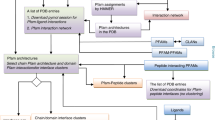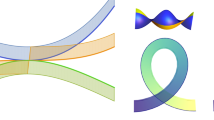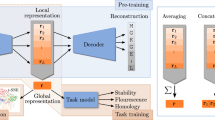Abstract
CONFORMATIONAL details of small molecules can easily be visualised in the usual stereo diagrams used by crystallographers, but such details cannot be readily visualised for protein molecules made up of thousands of atoms. For such large molecules special types of representations become necessary for depicting their three-dimensional structure, in the form of two-dimensional diagrams. In view of this, many attempts to represent the conformational details in protein molecules, have been reported1–7. I present here a new method for mapping the folding of the backbone polypeptide chain of protein molecules. This representation brings out all the features of protein folding, with no degeneracy caused by depicting the conformational details, and is useful in readily recognising all the secondary structures, without ambiguity, as one progresses along the chain.
This is a preview of subscription content, access via your institution
Access options
Subscribe to this journal
Receive 51 print issues and online access
$199.00 per year
only $3.90 per issue
Buy this article
- Purchase on Springer Link
- Instant access to full article PDF
Prices may be subject to local taxes which are calculated during checkout
Similar content being viewed by others
References
Phillips, D. C. in British Biochemistry Past and Present (ed. Goodwin, T. W.) 11–28 (Academic, London, 1970).
Ooi, T. & Nishikawa, K. in Jerusalem Symp. quant. Chem. Biochem. (ed. Bergamann, B. D. & Pullman, B.) 173–187 (1973).
Dunn, J. B. R. & Klotz, I. M. Archs Biochem. Biophys. 167, 615–626 (1975).
Balasubramanian, R. Int. J. Peptide Protein Res., 157–160 (1977).
Lewis, P. N., Momany, F. A. & Scheraga, H. A. Biochim. biophys. Acta 303, 211–229 (1973).
Srinivasan, R., Balasubramanian, R. & Rajan, S. S. J. molec. Biol. 98, 739–747 (1975).
Balasubramanian, R. & Srinivasan, R. Curr. Sci. 45, 397–398 (1976).
Ramachandran, G. N., Ramakrishnan, C. & Sasisekharan, V. J. molec. Biol. 7, 95–99 (1963).
Ramachandran, G. N. Biopolymers 6, 1494–1495 (1968).
Ramakrishnan, C. & Balasubramanian, R. Int. J. Peptide Protein Res. 4, 79–90 (1972).
Kolaskar, A. S., Lakshminarayanan, A. V., Sarathy, K. P. & Sasisekharan, V. Biopolymers 14, 1081–1094 (1975).
Ramachandran, G. N. & Sasisekharan, V. Adv. Protein Chem. 23, 283–438 (1968).
Birktoft, J. J. & Blow, D. M. J. molec. Biol. 68, 187–240 (1972).
Venkatachalam, C. M. Biopolymers 6, 1425–1436 (1968).
Balasubramanian, R. Indian J. Biochem. Biophys. 13, 289–292 (1976).
Shotton, D. M. & Watson, H. C. Nature 225, 811–816 (1970).
Nishikawa, K. & Ooi, T. J. theoret. Biol. 43, 351–374 (1974).
Author information
Authors and Affiliations
Rights and permissions
About this article
Cite this article
BALASUBRAMANIAN, R. New type of representation for mapping chain-folding in protein molecules. Nature 266, 856–857 (1977). https://doi.org/10.1038/266856a0
Received:
Accepted:
Issue Date:
DOI: https://doi.org/10.1038/266856a0
Comments
By submitting a comment you agree to abide by our Terms and Community Guidelines. If you find something abusive or that does not comply with our terms or guidelines please flag it as inappropriate.



